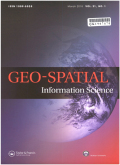- 钛学术文献服务平台 \
- 学术期刊 \
- 基础科学期刊 \
- 天文学、地球科学期刊 \
- 地球空间信息科学学报(英文版)期刊 \
Modelling impacts of high-speed rail on urban interaction with social media in China's mainland
Modelling impacts of high-speed rail on urban interaction with social media in China's mainland
基本信息来源于合作网站,原文需代理用户跳转至来源网站获取
摘要:
High-Speed Rail (HSR) has increasingly become an important mode of inter-city transportation between large cities. Inter-city interaction facilitated by HSR tends to play a more prominent role in promoting urban and regional economic integration and development. Quantifying the impact of HSR's interaction on cities and people is therefore crucial for long-term urban and regional development planning and policy making. We develop an evaluation framework using toponym information from social media as a proxy to estimate the dynamics of such impact. This paper adopts two types of spatial information:toponyms from social media posts, and the geographical location information embedded in social media posts. The framework highlights the asymmetric nature of social interaction among cities, and proposes a series of metrics to quantify such impact from multiple perspectives–including interaction strength, spatial decay, and channel effect. The results show that HSRs not only greatly expand the uneven distribution of inter-city connections, but also significantly reshape the interactions that occur along HSR routes through the channel effect.

推荐文章
An experimental study of interaction between pure water and alkaline feldspar at high temperatures a
Alkaline feldspar
Autoclave
High-temperature and high-pressure experiments
Assessment of bacterial biomass in the highly contaminated urban Nanming River, Guiyang, SW China
δ13C
δ15N
Bacterial biomass
N budget
Nanming River
High oxygen fugacity magma: implication for the destruction of the North China Craton
High oxygen fugacity
Decratonization
North China Craton
Plate subduction
Ecological stoichiometry of nitrogen, phosphorous, and sulfur in China's forests
Forest
Stoichiometry
Nitrogen
Phosphorous
Sulfur
China
内容分析
关键词云
关键词热度
相关文献总数
(/次)
(/年)
文献信息
| 篇名 | Modelling impacts of high-speed rail on urban interaction with social media in China's mainland | ||
| 来源期刊 | 地球空间信息科学学报(英文版) | 学科 | |
| 关键词 | |||
| 年,卷(期) | 2021,(4) | 所属期刊栏目 | Articles |
| 研究方向 | 页码范围 | 638-653 | |
| 页数 | 16页 | 分类号 | |
| 字数 | 语种 | 英文 | |
| DOI | |||
五维指标
引文网络
引文网络
二级参考文献 (0)
共引文献 (0)
参考文献 (0)
节点文献
引证文献 (0)
同被引文献 (0)
二级引证文献 (0)
2021(0)
- 参考文献(0)
- 二级参考文献(0)
- 引证文献(0)
- 二级引证文献(0)
引文网络交叉学科
相关学者/机构
期刊影响力
地球空间信息科学学报(英文版)
主办单位:
武汉大学(原武汉测绘科技大学)
出版周期:
季刊
ISSN:
1009-5020
CN:
42-1610/P
开本:
16开
出版地:
武汉市珞瑜路129号武汉大学测绘校区
邮发代号:
创刊时间:
1998
语种:
eng
出版文献量(篇)
958
总下载数(次)
0
总被引数(次)
2719
期刊文献
相关文献
推荐文献
- 期刊分类
- 期刊(年)
- 期刊(期)
- 期刊推荐
力学
化学
地球物理学
地质学
基础科学综合
大学学报
天文学
天文学、地球科学
数学
气象学
海洋学
物理学
生物学
生物科学
自然地理学和测绘学
自然科学总论
自然科学理论与方法
资源科学
非线性科学与系统科学
地球空间信息科学学报(英文版)2022
地球空间信息科学学报(英文版)2021
地球空间信息科学学报(英文版)2020
地球空间信息科学学报(英文版)2019
地球空间信息科学学报(英文版)2018
地球空间信息科学学报(英文版)2017
地球空间信息科学学报(英文版)2016
地球空间信息科学学报(英文版)2015
地球空间信息科学学报(英文版)2014
地球空间信息科学学报(英文版)2013
地球空间信息科学学报(英文版)2012
地球空间信息科学学报(英文版)2011
地球空间信息科学学报(英文版)2010
地球空间信息科学学报(英文版)2009
地球空间信息科学学报(英文版)2008
地球空间信息科学学报(英文版)2007
地球空间信息科学学报(英文版)2006
地球空间信息科学学报(英文版)2005
地球空间信息科学学报(英文版)2004
地球空间信息科学学报(英文版)2003
地球空间信息科学学报(英文版)2002
地球空间信息科学学报(英文版)2001
地球空间信息科学学报(英文版)2000

 免费查重
免费查重










